Pixels! I need more pixels!
Samsung has just tripped the switch in my wallet with the cheapest yet UHD monitor from a major vendor: Samsung 28-Inch Ultra High Definition LED Monitor (U28D590D) ($580 on sale when I bought it, I see the price has gone up a bit as I write this).
Naturally, since I don't have a video output that can drive this thing at the full UHD 3840x2160 resolution at 60HZ, I also needed to get a new video card: EVGA GeForce GTX 750Ti. A few folks said they bought this specifically to drive a 4K monitor, and it worked for them, so I'm giving it a try (who knows what the story on linux will be though, I suspect I'll probably have to use the binary nvidia drivers rather than nouveau, at least that's what this phoronix review indicates).
While I was at it, I threw in a display port cable. I like the idea of a latching cable that won't fall out.
This stuff is all destined to be delivered tomorrow (July 5th, 2014), so I'll be able to find out how easy it is to get working on linux when it shows up.
Since I have absolutely no place to put this thing near my main computer, I decided to get Fedora 20 genned up on an older system I use for testing and plug everything in there when it shows up. Since the old system just has a stock Intel CPU cooler, it is kind of noisy, and if I'm going to use it a lot I'd like it to be quiet, so I measured things and believe I can fit a Noctua NH-D14 120mm & 140mm SSO CPU Cooler in the case. It is the same cooler I use in my main computer, and I already know it is dead quiet.
With no convenient place to put it at home, maybe I'll tote it in to work to upgrade my current workstation and make everyone jealous :-).
Well, it is July 5th, and amazingly, everything showed up before 10 AM. This box was inside a much much bigger box along with probably half of amazon's supply of crumpled brown paper :-).
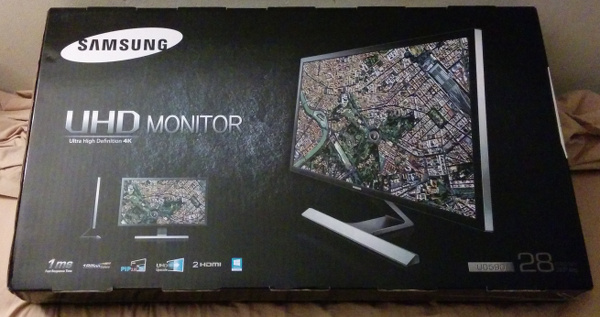
Unpacking it reveals this collection of stuff (it did come with both an HDMI and a Display Port cable, so I didn't really need to order a cable, but I still like the idea of a latching cable).
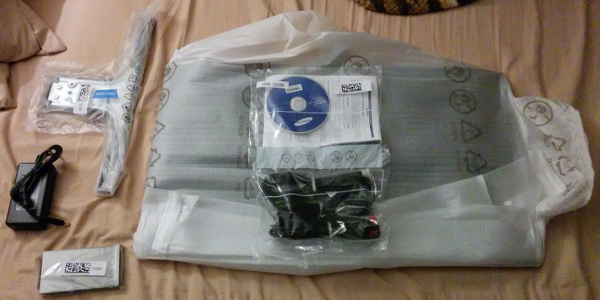
Putting the stand together (you do need a screwdriver) produces this:
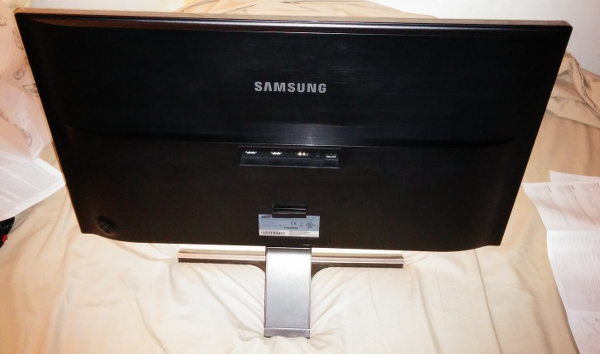
And plugging it into the computer with a DVI to HDMI cable I had shows that it works fine in low res 1920x1080 mode on the existing video:
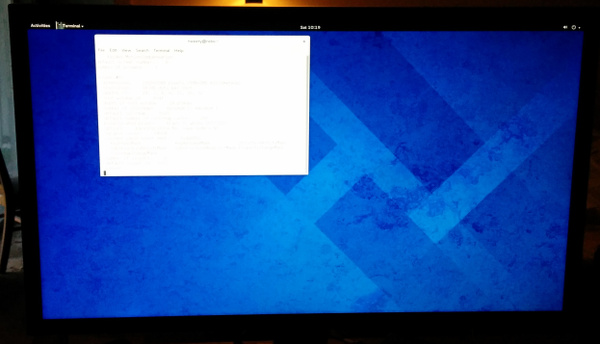
Now for the new video card...
The card (EVGA GTX 750Ti) went in the machine just fine, and works perfectly well in console text mode, but the open source nouveau driver cannot run it in UHD resolution (as expected).
Unfortunately, the nvidia binary drivers from rpmfusion also do not work, but they don't work in a really weird fashion: X believes it is up. I can look at the Xorg.0.log file and see no errors of any kind (and see that it auto selected 3840x2160 resolution), but the screen is black until I Ctrl-Alt-F2 into a console, which still works fine.
So now it becomes a research project... First thing to do is probably try another cable, then maybe try ubuntu, then maybe try Windows (I do have a Windows disk I could install as long as I don't try to activate). I'd like to verify something works at UHD resolution :-).
Different cable didn't have any effect.
Installing Windows 7 did work though (which confirms all the hardware is fine). Here's the resolution selection screen with default values:
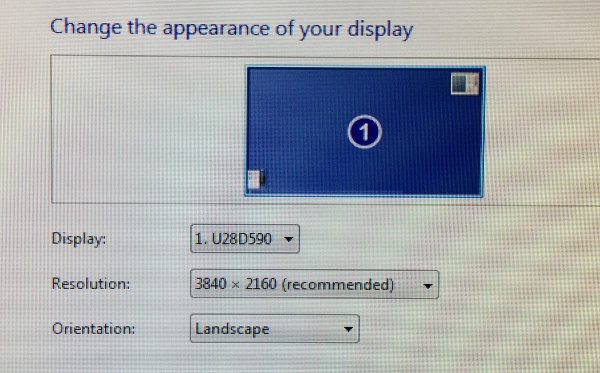
I have a feeling my problem now is that the version of the nvidia drivers on rpmfusion.org/ is quite a lot older than the latest version provided at the nvidia web site (which is up to 337.25 while rpmfusion has various 331 flavors).
Let there be pixels!
Thanks to negativo17.org/ and his alternate nvidia driver repos (which I found with a google for "nvidia 337.25 fedora"), I now have Fedora 20 displaying full UHD resolution:
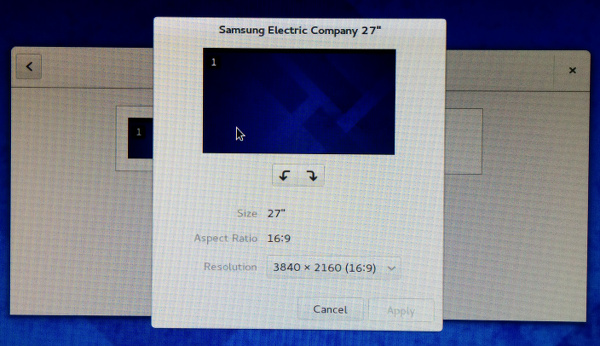
There was even a dramatic rumble of thunder outside when I finally rebooted into UHD mode :-).
Next comes lots of tweaking to make things big enough to see (which partly depends on how far away the monitor is going to be in normal usage).
July 6th has arrived and GAAAAH! I installed a bunch of stuff that was missing from the live image I started with, and when I booted this morning, the screen is blank again! I have no idea what killed it (though I suspect some mesa stuff that came along with the updates).
What works?
Perhaps someday, I'll start over with fedora 20 and do a binary search to find which packages broke the nvidia drivers, but for now I've switched to ubuntu 14.04 and added the xorg-edgers ppa repo to get bleeding edge X and nvidia. It seems to work fine (but so did fedora just a day ago, so time will tell).
Possibly by the time fedora 21 comes out things will have advanced in X and I'll be able to use it without breaking again (heck, maybe by fedora 22, the nouveau driver will be functional).
Update: I did a different trick to get Fedora working. From feedback I got in bug 3277, I installed the rpmfusion nvidia driver again, then enabled the rawhide rpmfusion repos and updated all things nvidia to get just the nvidia drivers from rawhide, but not the rest of the universe. So far this has been working (though GL apps don't seem to be able to do 3D stuff).
Tips and Tricks
In emacs, M-x set-frame-font to something like Monospace-18 to get a bigger font you can actually see (I know that doesn't seem to correspond to any of the cryptic font specs that emacs uses and documents, but it is able to interpret it and turn it into the gibberish emacs uses internally). You can run (frame-properties) to see what font property emacs generates from an abbrev like this. Actually, if you have the inconsolata fonts, they work really well for text editors on such a high resolution display. I finally think they might be an improvement on the old X11 9x15 font :-).
In google-chrome, go to Settings, click on Show Advanced Settings..., then under the Web content section there is a Page zoom you can set to something larger than 100% to automagically zoom everything. (Well, everything inside the web pages. Nothing seems to make the menu bars and other local chrome controls bigger).
In the unity desktop, goto Settings/Displays and a drag the scale value slider for the text/icon size to make things bigger. I'm pretty sure this controls the dconf setting org.gnome.desktop.interface.text-scaling-factor which you can set with something like dconf-editor in a gnome session.
Hey! xterm is smarter than you think! See: Hidden gems of xterm. You can enable UTF-8 support and see error messages instead of gibberish. You can also get it to use all the fonts, not just the bitmap fonts, so it is possible to make it big enough to see on this monitor.
Fvwm has the CursorStyle command which can accept image files to specify cursors, so it is possible to whip out some png files in gimp to make pointers big enough to see for the root window and title bars and such. Just be aware that it inverts the colors when displaying the cursor (black and white get reversed).